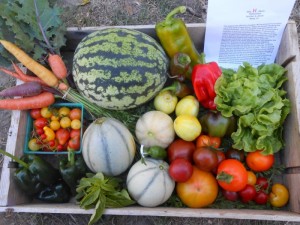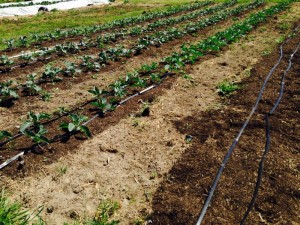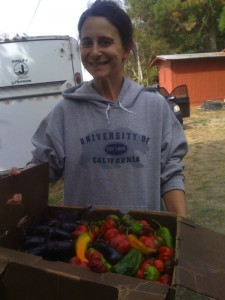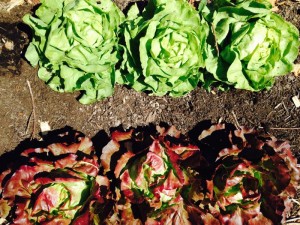Here on the Garden Club blog, we love introducing our readers to some great, hard-working local farmers around the North Bay as part of our Meet Your Local Farmer series. This week, in celebration of Compost Week Awareness Week, I drove out to Sebastopol to chat with my friend Caiti Hachmyer of Red H Farm.
I’m pretty sure that Caiti is an undercover superhero–not only is she active in both local and international food justice work, but she also grows beautiful and tasty produce 7 days a week and does it all with a smile and a desire to better our understanding of food systems and sustainable agriculture. I caught her in a rare moment of rest and she graciously gave me a tour of her farm to discuss compost and the ways she employs it at Red H. This is particularly interesting because some of her fields are cultivated with a tractor and use moderate amounts of compost, while others are transitioning to a no-till system which uses massive compost applications. No-till farming is an age-old practice that limits tillage and subsequent disruption of the soil, and aims instead to build the soil’s capacity through natural systems. Let’s find out why Caiti is taking the leap:
Caiti, we’re so excited to feature you on the blog this week. You’ve got your hands in many projects and run a beautiful farming operation to boot. Why don’t you tell us the history of Red H farm and a little bit about all your other endeavors?
I started Red H Farm in 2009 on the acre of land where I grew up in south Sebastopol. I studied sustainable agriculture and political ecology at UC Berkeley, and then worked for a couple of non-profit organizations in the East Bay (CAFF and Food First) before deciding I needed hands-on farming experience to better inform the advocacy I was interested in doing. I moved out to western Minnesota to spend the season on a big CSA farm to learn about farming life on the ground. When I finished up my apprenticeship, I planned to come back to the Bay Area and start working on the political/advocacy side of things again. But, this was at the end of 2008 and our economy had just collapsed. I was having a hard time finding a job, but then I realized that I just acquired this huge new farming skill set and decided to put my apprenticeship to work.
And so began Red H Farm – a total bootstrap operation. I was farming five days a week, waitressing on Saturdays, and working at the Seed Bank in Petaluma on Sundays. It wasn’t my plan, but it all kind of fell together. Once I started farming it was hard to imagine NOT farming. However, I’ve always been really interested in working on the food systems level as well, so I took a season off from farming in 2012 to complete a master’s degree focused on food systems policy and planning.
Now I’m finding ways to do both kinds of work: farming is my day job, and in addition I do things like research consultancies at Food First, sit on the board of Petaluma Bounty, and participate in speaking engagements about land tenure and urban agriculture.
What does a typical day on the farm look like for you?
My day might be a little non-traditional in terms of general presumptions about farmers – specifically, I’m not an “up before dawn” kind of person. I relish a slow morning rather than jumping out of bed and being out the door in 15 minutes.
My days usually start around 6:30 or 7. After coffee, breakfast and the news or a chapter in whatever book I’m reading I head out to tend the greenhouses and do a quick walk through to see how crops are looking. From there, each day varies depending on what is on the top of my priority list. If I’ve got a few days of cooler weather, then I might spend all day transplanting crops into the field. If we’re having spring scorchers, then I might take that time to move compost and mulch, lay irrigation and do general bed prep.
Saturdays are always a harvest day and Sunday I’m always at the market. I try to lay out the priorities for the week and then schedule out the days based on what needs to be accomplished overall while paying attention to weather, the schedules of contractors I might be working with (folks doing things like tractor work or delivering compost), and the time sensitivity of various projects and other activism work I have scheduled. I usually break for a quick lunch, and then get back to work until about 6:30 or 7pm!
I’ve tasted some of your delicious greens and beans too. What are your other main crops? Where and how do you market them?
Because Red H Farm is a CSA farm, we grow a huge diversity of crops, with a focus on heirloom varieties. We grow a lot of variety for the CSA, and then ramp up production of certain things to bring to the Sebastopol Farmers Market – this time of year spinach and lettuce are two of our best crops at the market. We’ve tried out a lot of heirloom varieties from Petaluma Seed Bank over the years, and work with varieties from other seed companies like Johnny’s, Fedco and High Mowing Seeds. We’ve honed in on what we like best and what does well in our little microclimate. One defining thing about our farm is that it sits in a little cool pocket of south Sebastopol, so we are able to harvest lettuce and greens all summer long. Some other farm favorites include over 20 varieties of heirloom cherry tomatoes, French heirloom melons and winter squash.

We’d love to hear about your cultivation practices, your transition into no-till farming, and your compost usage here at Red H. What’s the process been like?
We’ve been transitioning the farm to no-till for about 2 years now. It requires a lot of compost and mulch, so it’s been a slow process as we move and transition section by section through the fields. The specific system we use includes putting a thick layer of compost on each bed and mulching all the pathways with wood chips that we either buy or have dropped off by tree trimmers when they’re working in the area. Each time a bed of crops is harvested and re-planted, we add more compost on top to act as a mulch layer.

Before deciding to farm no-till, we would incorporate 10-15 yards of compost into the soil each spring before planting – we typically hire in tractor work, so I would either spread compost first, or spread it after the ground was tilled and use hand tools to incorporate it into beds. Compost is particularly important in our sandy soil to help build organic matter and add nutrients that won’t leach out.
We talk about compost a lot here on the blog. What do you look for in compost when sourcing it? What’s it doing for your soil?
I prefer to use higher nutrient compost because I rarely use other fertilizers. For example, I look for components that will add extra nitrogen organically so I don’t have to supplement. The more compost I use, the richer I can see my soil is getting. The goal is to build up the organic matter in the soil over time, and I think using compost and mulch is definitely the best way to do that. I like to use wood chips because they decompose slowly over time, and using chips alongside compost builds amazing microbial and mycorrhizal activity in the soil.
Let’s talk more about what you’re doing to care for and build your soil. What made you what made you take the leap into no-till farming?
There are a lot of reasons why I decided it was the best system for the farm. From the agricultural perspective, we’ve been using something like 40-60 yards of compost per acre each season so we’re adding tons of organic matter, which is great for the soil. Using compost like a mulch layer on the top of each bed helps to hold in water in the immediate sense. In addition, adding organic matter to the soil helps its water-holding capacity in the long term as well – this is clearly going to be really important in this area for the foreseeable future. It is also great to NOT disturb the soil ecosystem by putting it through a blender multiple times a year. The soil maintains its structure and the critters are left intact. This is true aboveground, too – we see tons of snakes and lizards and even a fox that regularly passes through.
Another huge reason for going no-till is that our farm is in a low spot. It’s like a very slight valley, and all the water from around us just flows right down and sits on the farm in the winter so it gets pretty swampy. For three years in a row we had a tractor stuck out there in June! So, if we want to do any kind of early planting I realized we needed to stop relying on tractor work to get the land prepared. The other big reason that I like no-till is that I hate weeding! There will always be weeding to do, but there’s a lot less in the areas that have been no-till for two years now. And the final reason is that it’s beautiful! I love seeing the neat, wood-chipped pathways and clean beds. It feels like being in a huge garden.
What can you recommend to home gardeners in terms or making and/or using compost? Do you think no-till is a viable option for them?
I think no-till is a great option for home gardeners – if you can avoid having to rely on renting or borrowing a rototiller each year, why not? I’d definitely recommend building up regular beds either by sheet mulching, or by tilling one last time and then creating permanent beds with a really thick initial compost layer and mulching the pathways with wood chips. It’s such an aesthetically beautiful system, so I think it’s perfect for any gardening application. Admittedly, my experience is with sandy loam, so it might be more work if you’re dealing with heavy clay soils, but I know there are farmers doing it, so I think it’s still a plausible option.
How has the drought in California affected your farm?
Like I mentioned before, the farm sits really low on the landscape, which has been tough from the spring land prep perspective, but has been a blessing from the perspective of drought. Last year we didn’t have to start irrigating until late June and harvested lettuce early in the summer that had never been on drip. Right now its late April and we haven’t hooked up the drip at all yet, and I don’t foresee needing it for quite a while.
In general I dry farm tomatoes, potatoes and winter squash. Dry farming is the practice of growing crops with little or, preferably, zero irrigation. You can get away with it with some crops and not others, in some locations and not others. I know that I’m an exception – other farms are very, very dry already and have been running irrigation all spring. And I can definitely see that it might be a big issue for me with summer and fall crops in the future because I don’t have a fantastic well. I think no-till is a good option with regards to the drought because of the things we talked about earlier. I know that farms using cover cropping all had to be very careful this year to get it mowed down and incorporated at the right time because everything was drying out so fast. It’s been a huge issue already, particularly for livestock operations, but it’s going to have an increasingly drastic effect on everyone. And everyone – not just growers, but consumers as well – should be thinking about it.
What is your advice to young people in Sonoma County who are interested in becoming a farmer or getting involved in our local food system?
If you’re new to food systems work, do everything you can to learn as much as you can! Meet farmers, intern on farms, engage with organizations doing food justice work and learn about the food system from all perspectives. I think that’s what we need – farmers who understand the complexities of consumption, and consumers that understand the complexities of farming. Be both!
A huge thanks Caiti and Red H Farm for giving our readers a chance to meet their local farmer. Click here for more information about Red H Farm’s CSA program or how to find them at the Farmer’s Market. You can also reach them by phone at (707) 235-2596.










 Family
Family

